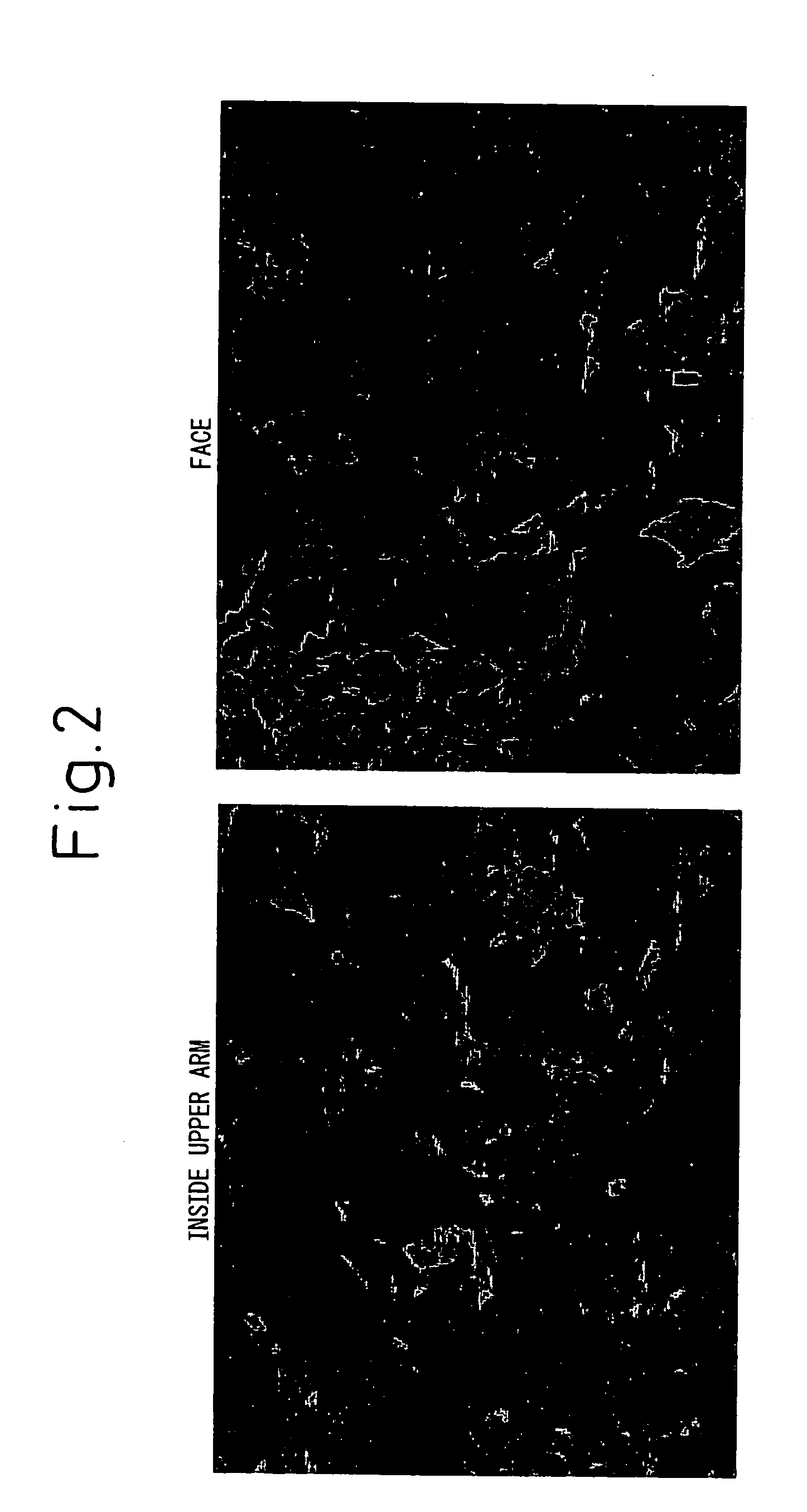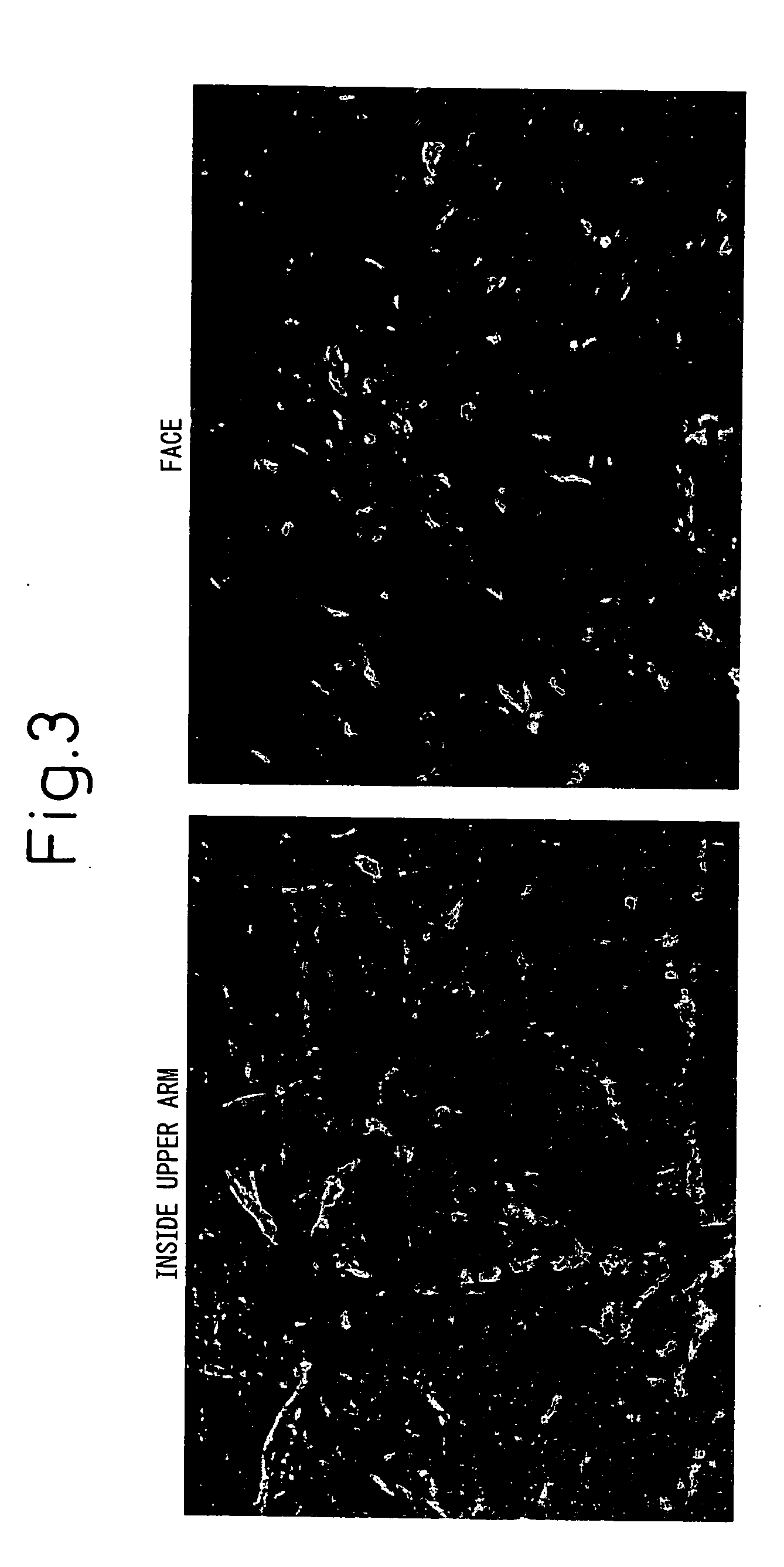Method for evaluating oxidized protein in horny cell layer
a horny cell layer and oxidized protein technology, applied in material analysis, fluorescence/phosphorescence, instruments, etc., can solve the problems of oxidation in a chain reaction, irritating the skin surface, damaging cells deep in the horny layer,
- Summary
- Abstract
- Description
- Claims
- Application Information
AI Technical Summary
Benefits of technology
Problems solved by technology
Method used
Image
Examples
example 1
Detection of Horny Layer Oxidized Protein Using Biotin Hydrazide
[0095] Transparent adhesive tape was attached to the face and inside upper arm of a healthy individual and immediately stripped off, to non-invasively obtain the outer layer of the horny layer. A 100 mM MES-Na buffer solution (pH 5.5) containing 5 mM biotin hydrazide (PIERCE Co.) was reacted therewith at room temperature for 1 hour. After completion of the reaction, thorough washing was carried out with phosphate-buffered saline (PBS), and then fluorescein-labeled avidin (product of Amersham-Pharmacia Biotech, diluted to 1:100 volume with PBS) was reacted therewith at room temperature for 1 hour. After completion of the reaction, thorough washing was carried out with PBS and a fluorescent microscope (Olympus BX52) was used for observation. The observed image is shown in FIG. 1.
[0096] As seen in FIG. 1, fluorescence was observed for both the inside upper arm and the face, indicating that oxidized protein had been suff...
example 2
Detection of Horny Layer Oxidized Protein Using Texas Red Hydrazide
[0097] Transparent adhesive tape was attached to the face (cheek) and inside upper arm of a healthy individual and immediately stripped off, to non-invasively obtain the outer layer of the horny layer. A 100 mM MES-Na buffer solution (pH 5.5) containing 20 μM Texas red hydrazide (Molecular Probes Co.) was reacted therewith at room temperature for 1 hour. After completion of the reaction, thorough washing was carried out with phosphate-buffered saline (PBS), and then a fluorescent microscope was used for observation. The observed image is shown in FIG. 2
[0098] As seen in FIG. 2 fluorescence was observed for both the inside upper arm and the face, thus clearly demonstrating that the oxidized protein was also labeled with Texas Red hydrazide, similar to fluorescein-5-thiosemicarbazide.
example 3
Detection of Horny Layer Oxidized Protein Using Dinitrophenylhydrazine (DNPH)
[0099] Transparent adhesive tape was attached to the face and inside upper arm of a healthy individual and immediately stripped off, to non-invasively obtain the outer layer of the horny layer. A 100 mM MES-Na buffer solution (pH 5.5) containing 200 μM dinitrophenylhydrazine (Wako Pure Chemical Industries Co., Ltd.) was reacted therewith at room temperature for 1 hour. After completion of the reaction, thorough washing was carried out with phosphate-buffered saline (PBS), and then a PBS solution (1 μg / ml) of rabbit anti-DNP antibody (ZYMED Co.) was reacted therewith at room temperature for 1 hour. After completion of the reaction, fluorescein-labeled anti-rabbit Ig (product of Amersham-Pharmacia Biotech, diluted to 1:100 volume with PBS) was reacted therewith at room temperature for 1 hour. After completion of the reaction, thorough washing was carried out with PBS and a fluorescent microscope was used fo...
PUM
 Login to View More
Login to View More Abstract
Description
Claims
Application Information
 Login to View More
Login to View More - R&D
- Intellectual Property
- Life Sciences
- Materials
- Tech Scout
- Unparalleled Data Quality
- Higher Quality Content
- 60% Fewer Hallucinations
Browse by: Latest US Patents, China's latest patents, Technical Efficacy Thesaurus, Application Domain, Technology Topic, Popular Technical Reports.
© 2025 PatSnap. All rights reserved.Legal|Privacy policy|Modern Slavery Act Transparency Statement|Sitemap|About US| Contact US: help@patsnap.com



